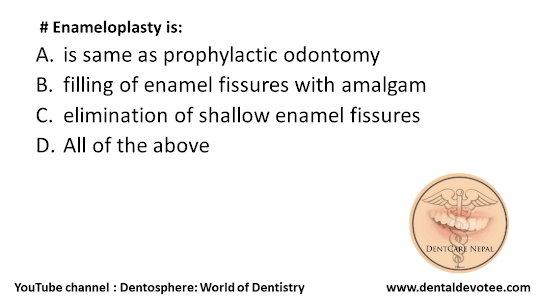# Enameloplasty is:
A. is same as prophylactic odontomy
B. filling of enamel fissures with amalgam
C. elimination of shallow enamel fissures
D. All of the above
The correct answer is C. Elimination of shallow enamel fissures.
Historically, enameloplasty was utilized as an ultraconservative procedure on the occlusal surfaces, which were deemed to be at risk of the development of a pit or issure caries lesion. Extreme prudence was exercised in the selection of these areas and in the depth of enamel removed. This procedure was never used unless the area could be transformed into a cleansable groove (or fossa) by a minimal reduction of enamel, and unless occlusal contacts could be maintained. This procedure technically included a preparation stage but no restoration stage. Currently, clinical situations such as these (ICDAS 1 or 2) are managed by treatment with luoride or placement of sealants. Research studies support the filling of issures/pits and narrow grooves/fossae (i.e., “sealing”) with low viscosity composite resin materials, without any mechanical alteration (enameloplasty) of the at-risk tooth anatomy.
Additionally, “prophylactic odontotomy” procedures were used in the past. These more aggressive procedures involved preparing developmental or structural imperfections of the enamel that were thought to be at increased risk of caries and filling the preparation with amalgam to prevent caries from developing in these sites. Prophylactic odontotomy is no longer advocated as a preventive measure.
Reference: Sturdevant’s Art and Science of Operative Dentistry, Seventh Edition, Page No 125





No comments:
Post a Comment
Add Your Comments or Feedback Here